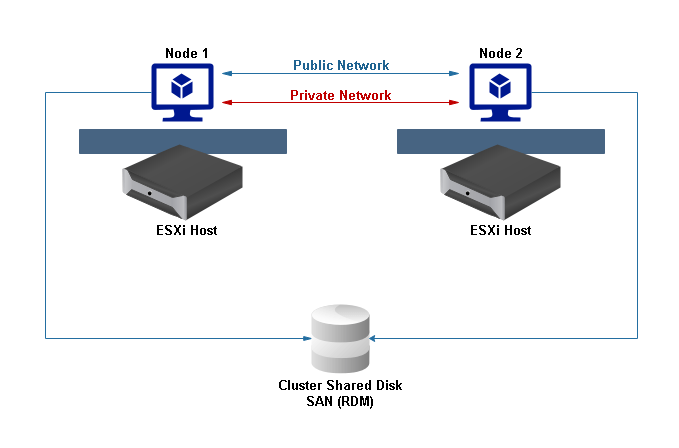
When you add hard disks to the second node, you set up the disks to point to the quorum disk and shared storage disks, if any, for the first node. The setup allows shared access to clustered services and data.

- In the vSphere Client, select the newly created virtual machine, right-click and select Edit Settings.
- Click the New device drop-down menu, select RDM Disk, and click Add.
- Select the LUN that is used by the physical machine.
- Select the datastore, which is also the location of the boot disk.
- Select Physical as the compatibility mode.
- Expand the New Hard Disk. From the Virtual Device Node drop-down menu, select a new SCSI controller (for example, SCSI (1:0)). Note: You must select a new virtual device node. You cannot use SCSI 0.
- Click OK.
- In the New Virtual Machine - Edit Settings dialog box, expand SCSI controller and select the Change Type drop-down menu.
- Select the appropriate type of controller, depending on your operating system. Operating System
Type of Controller Windows Server 2003 LSI Logic Parallel Windows Server 2008 LSI Logic SAS and VMware Paravirtual - Click OK.
- In the New Virtual Machine - Edit Settings dialog box, expand SCSI controller and select the SCSI Bus Sharing drop-down menu. Set SCSI Bus Sharing to Virtual and click OK.

Vmware 6.7 Windows Cluster Shared Disk
Windows cluster health monitoring: The value of the SameSubnetThreshold Parameter of Windows cluster health monitoring must be modified to allow 10 missed heartbeats at minimum. It's the default in Windows Server 2016. This recommendation applies to all applications using WSFC, including shared and non-shared disks. After configuring a clustered VMDK a user needs to extend the size of the clustered (shared) disk. Note: One of the common examples of using a clustered VMDK is Windows Server Failover Cluster (WSFC) with a disk resource shared across multiple VMs (starting with vSphere 7.x).